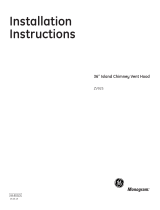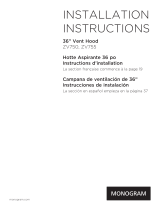Monogram Vent Hood Owner's manual
- Category
- Cooker hoods
- Type
- Owner's manual
This manual is also suitable for
Monogram ZV950, a 36" stainless steel vent hood, offers powerful ventilation for your kitchen. Designed for general ventilating use, it efficiently removes cooking odors, smoke, and grease, creating a fresher and cleaner indoor environment. With its sleek design and high-quality construction, this vent hood not only enhances the functionality of your kitchen but also adds a touch of elegance.
Monogram ZV950, a 36" stainless steel vent hood, offers powerful ventilation for your kitchen. Designed for general ventilating use, it efficiently removes cooking odors, smoke, and grease, creating a fresher and cleaner indoor environment. With its sleek design and high-quality construction, this vent hood not only enhances the functionality of your kitchen but also adds a touch of elegance.












-
 1
1
-
 2
2
-
 3
3
-
 4
4
-
 5
5
-
 6
6
-
 7
7
-
 8
8
-
 9
9
-
 10
10
-
 11
11
-
 12
12
Monogram Vent Hood Owner's manual
- Category
- Cooker hoods
- Type
- Owner's manual
- This manual is also suitable for
Monogram ZV950, a 36" stainless steel vent hood, offers powerful ventilation for your kitchen. Designed for general ventilating use, it efficiently removes cooking odors, smoke, and grease, creating a fresher and cleaner indoor environment. With its sleek design and high-quality construction, this vent hood not only enhances the functionality of your kitchen but also adds a touch of elegance.
Ask a question and I''ll find the answer in the document
Finding information in a document is now easier with AI
in other languages
Related papers
-
GE ZV800BJBB User manual
-
Monogram ZV800SJSS Installation guide
-
GE MONOGRAM ZV900 User manual
-
Monogram ZV900SLSS Installation guide
-
Monogram ZV950SDSS Installation guide
-
GE ZX83012 Installation guide
-
GE ZV891YSS Installation guide
-
GE ZV750 Installation guide
-
Monogram ZV925 Installation guide
-
GE ZV755SPSS Installation guide
Other documents
-
Richelieu Hardware 496GRI12BC Installation guide
-
GE ZV830 User manual
-
 Young House Love VKR001-CO-U Installation guide
Young House Love VKR001-CO-U Installation guide
-
GE ZV421 ZV541 User manual
-
 GE Monogram GEZV925SLSS Installation guide
GE Monogram GEZV925SLSS Installation guide
-
GE ZV900SL3SS Installation guide
-
 GE Monogram ZV750SPSS DL 4819b9549723c992563f9f0361cf
GE Monogram ZV750SPSS DL 4819b9549723c992563f9f0361cf
-
GE ZV755SP1SS Installation guide
-
GE JV936DSS User guide
-
GE PV970NSS Owner's manual














